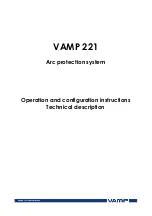
A–2
LM10 MOTOR PROTECTION SYSTEM – INSTRUCTION MANUAL
DEVICENET OVERVIEW
CHAPTER A:
A.1.2 Controller Area Network (CAN)
The Controller Area Network (CAN) is a broadcast-oriented communications protocol.
DeviceNet uses CAN for its data link layer. The CAN protocol has a fast response and high
reliability for demanding applications such as control of anti-lock brakes and air-bags.
Devices are now available for the industrial automation market demanding stability in high
temperature and high noise immunity.
A.1.3 DeviceNet Operations
DeviceNet is a connection based protocol; that is, all devices should establish a connection
prior to exchanging information. DeviceNet adopts the object modelling approach – all
information is structured in different objects. Services (such as Get and Set) can be applied
to these objects to extract/change information. The following are the typical object classes
found in a DeviceNet product:
1.
Identity
object. Identification information (such as vendor ID, device profile, revision,
etc.) of a device are stored in this object. Users can identify a particular object by
remotely access to this object.
2.
Message Router
object. This object handles the explicit messages received by routing
it to the proper destination objects.
3.
DeviceNet
object. A DeviceNet product will typically have a single instance of the
DeviceNet object. This instance would have as attributes: node, address, or MAC ID,
baud rate, bus-off action, bus-off counter, allocation choice, and the master MAC ID.
The only required service is Get_Attribute_Single.
4.
Connection
object. This object handles the connection of the module, such as Explicit
Messaging or Input/Output Messaging. Explicit messages contain attribute
addressing, attribute values and a service code describing the desired action. Input/
output messages contain nothing but data. In an input/output message, all
information about how to process the data is contained in the Connection object
associated with that I/O message
5.
Assembly
object(s). A DeviceNet product typically has one or more optional Assembly
objects. The primary purpose of these objects is to group different attributes (data)
from different application objects into a single Attribute.
6.
Parameter
object. The optional Parameter object is used in parameter-based devices.
One instance would be presented for each configurable parameter. The Parameter
object provides a standard method for a configuration tool to access all parameters.
Attributes of the Parameter object could include values, ranges, text strings, and limits.
7.
Application
objects. Usually at least one application object besides those from the
Assembly or Parameter class will be present in a device. There are a number of
standard objects in the DeviceNet object library.
Each object has its own parameters called attributes (such as vendor ID). The behavior of a
device is governed by these attributes.
Once the connection is established, all the data exchanged across this connection are
handled by the corresponding connection instance.
Summary of Contents for LM10
Page 6: ...1 IV LM10 MOTOR PROTECTION SYSTEM INSTRUCTION MANUAL TABLE OF CONTENTS ...
Page 18: ...1 12 LM10 MOTOR PROTECTION SYSTEM INSTRUCTION MANUAL SPECIFICATIONS CHAPTER 1 INTRODUCTION ...
Page 70: ...5 64 LM10 MOTOR PROTECTION SYSTEM INSTRUCTION MANUAL SERIAL PORT CHAPTER 5 COMMUNICATIONS ...
Page 74: ...6 68 LM10 MOTOR PROTECTION SYSTEM INSTRUCTION MANUAL WARRANTY CHAPTER 6 MISCELLANEOUS ...
Page 106: ...I 4 LM10 MOTOR PROTECTION SYSTEM INSTRUCTION MANUAL INDEX ...










































